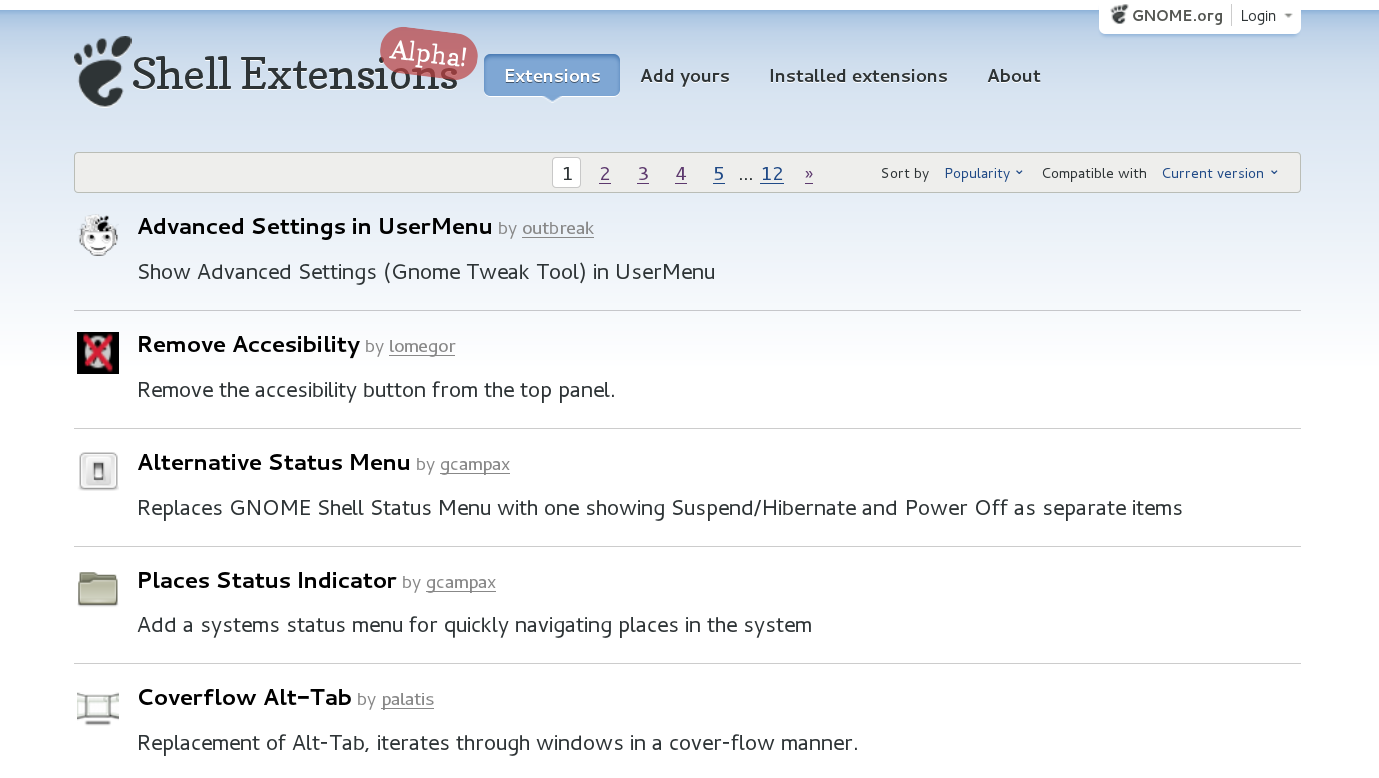| Fedora Test Days | |
|---|---|
| GNOME 3 (pre-F15 Final) | |
| Date | 2012-03-15 |
| Time | all day |
| Website | http://www.gnome3.org |
| IRC | #fedora-test-day (webirc) |
| Mailing list | test |
What to test?
Today's instalment of Fedora Test Day will focus on gnome-shell extension management. Since the release of GNOME 3 about a year ago there's been a great progress in ways one can customize it. Remember applets, desktop widgets etc. back in GNOME 2? Missed them? Now we have all that back in form of gnome-shell extensions! Shell's architecture makes it relatively painless to make them and a lot of useful extensions are already out.
There are several ways one can manage gnome-shell extensions. In addition to having gnome-tweak-tool, extension management has also been integrated with Firefox and https://extensions.gnome.org/, where you can search for and install extensions as well as enable/disable them. Haven't tried it yet? Go on, it's really nice! And while you're at it, please help us test these various ways of extension management by following the few test cases over here, catching bugs and thus contributing in efforts of making extensioning gnome-shell what all have been waiting for!
Who's available
The following cast of characters will be available for testing, workarounds, bug fixes, and general discussion ...
- Development - Matthias Clasen (mclasen)
- Quality Assurance - Adam Williamson (adamw), Vítězslav Humpa (vhumpa), Radek Lát (rlat)
Prerequisite for Test Day
- An updated Fedora 15 pre-release, or the specific Test Day live image.
- Your hardware profile uploaded to Smolt according to these instructions
- For most testing, a graphics adapter capable of compositing: we are aiming to support all NVIDIA GeForce adapters, all Intel adapters except for GMA 500 (Poulsbo) and pre-i915 (i8xx) adapters, and all ATI/AMD Radeon adapters. If you are using an unsupported adapter, you can still help us with fallback testing - see below.
Also helpful, if you have or can get them:
- Additional displays (monitors, TVs...)
- As many storage devices as you can access
- Optical media (burned, commercially pressed, and blank burnable, CDs, DVDs and Blu-Rays)
- Wi-fi/bluetooth enabled networking devices
- Graphics adapters, virtual machines, or driver configurations not capable of compositing, to test fallback support (see below)
How to test?
Live image
You may download a non-destructive pre-Fedora 15 live image for your architecture. Tips on using a live image are available at FedoraLiveCD.
| Architecture | SHA256SUM |
|---|---|
| i686 | 9af0d24337a435d9c3f10fb34d1f16af7d6496b10ca0facf1a0630b45a66d544
|
| x86_64 | 7d69f8324afc3de809144ff4104879c2240f3017e4db84cf5ed0d0259abb83e1
|
Using the live image is the easiest way to participate in testing for most people, but alternatively you can:
Update your machine to Fedora 15
If you are already running or want to try the pre-release of Fedora 15, install Fedora 15 Beta and then update to the latest packages. Using the live image is easier and highly recommended.
Perform testing
Please perform as many of the test cases listed as you have the time and the resources to complete, and fill out your results in the table below. You do not need a Fedora account to fill in the table.
Fallback testing
This test case will test that GNOME falls back correctly to a 'classic' environment if your hardware does not support the GNOME Shell. If your hardware starts GNOME Shell correctly, please leave the fallback test column empty, and fill in the other test result columns. If your hardware is unable to start GNOME Shell, but falls back correctly to a classic environment, please mark the fallback test in the results table as 'pass', and leave the other test columns empty. If your hardware is unable to start GNOME Shell, and does not fall back correctly to a classic environment, please mark the fallback test in the results table as 'fail', file a bug against ![]() gnome-session
gnome-session
Regular tests
- QA:Testcase_gnome-shell_dash
- QA:Testcase_gnome-shell_workspaces
- QA:Testcase_gnome-shell_overview_search
Unplanned testing
As well as running the formal test cases, you can help simply by running GNOME 3 and reporting any problems you come across in the course of your typical use, even if they do not match up with any of the test cases. Please remember, though, that just being different from GNOME 2 is not necessarily a problem, and check in #fedora-test-day before you file a bug.
Test Results
If you have problems with any of the tests, try and report a bug. Most bugs in this event should be reported to GNOME Bugzilla. Bugs that are clearly issues in Fedora GNOME integration should be reported to Fedora Bugzilla. You will need an account to report bugs, but creating one is easy, and we will help you do this if you ask in IRC.
If you are not sure of the appropriate component, please check in IRC before filing, there are many possibilities. If you are unsure about exactly how to file the report or what other information to include, just ask on IRC and we will help you.
Once you have completed the tests, add your results to the Results table below, following the example results from the first line as a template. The first column should be your name with a link to your User page in the Wiki if you have one, and the second should be a link to the Smolt profile of the system you tested. For each test case, use the result template to describe your result, following the examples in the Sample user row.
| User | Smolt Profile | Dash | Workspaces | Search | References |
|---|---|---|---|---|---|
| Sample User | HW | ||||
| User | Smolt Profile | Dash | Workspaces | Search | References |

